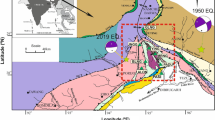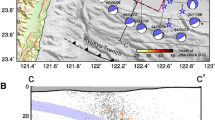Abstract
Modelling of earthquake source locations and parameters infers seismogenesis of earthquakes. In this study, we modelled the earthquake source locations through hypocenter location algorithm using the difference in arrival time of P and S waves and source parameters through the Levenberg–Marquardt non-linear inversion method using S-wave spectra. A total of 340 aftershocks of 2001 Bhuj mainshock (\( 1.8 \le M_{w} < 4.3 \)), which have occurred in Kachchh, Gujarat, India from January 2014 to January 2015, are located in this study. Out of 340 aftershocks, digital waveforms of 78 aftershocks (\( 2.2 \le M_{w} < 3.9 \)) are used for estimation of the earthquake source parameters. The results obtained from earthquake locations show two clusters of seismicity along the Kachchh Mainland Fault (KMF) and North Wagad Fault (NWF) and three felt events (\( M_{w} \ge 3.0 \)); one along the Katrol Hill Fault (KHF) (\( M_{w} = 3.3 \)), two along the Banni Fault (BF) (\( M_{w} = 3.0,3.2 \)). The generation of these three felt events is attributed to the triggering mechanisms caused by the migration of fluids or the stress pulse generated by the 20 MPa stress drop of the Mw 7.7 Bhuj earthquake. A marked concentration of events is noticed in 15–30 km depth range, which could be attributed to the presence of a mafic intrusive body, resulting in stress build-up for earthquake generation in this region. The results of source parameters; seismic moment (M0), source radius (r) and stress drop (Δσ) vary from 1.86 × 1012 to 3.2 × 1015 N m, 146–262 m and 0.04–5.73 MPa, respectively. The maximum stress drop value is estimated to be 5.73 MPa at 24 km depth for the largest studied event of \( M_{w} \) 3.9. Large stress drops are confined to the 8–33 km depth range, which indicates the probable existence of the base of the seismogenic layer in this depth range. This observed large stress drops could be attributed to stresses induced by crustal mafic intrusive bodies and the presence of aqueous fluids in the lower crust below the region.






Similar content being viewed by others
References
Aki K 1962 Revision of some results obtained in the study of the source function of Rayleigh waves; J. Geophys. Res. 67 3645–3647.
Antolik M and Dreger D S 2003 Rupture process of the 26 January 2001 Mw 7.6 Bhuj, India, earthquake from teleseismic broadband data; Bull. Seismol. Soc. Am. 93 1235–1248.
Archuleta R J, Cranswick E, Muellar C and Spudich P 1982 Source parameters of the 1980 Mammoth Lakes, California, earthquake sequence; J. Geophys. Res. 87 4595–4607.
Baumbach M, Grosser H, Schmidt H G, Paulat A, Rietbrock A, Rao C V R K, Soloman Raju P, Sarkar D and Mohan 1994 Study of the foreshocks and aftershocks of the intraplate Latur earthquake of September 30, 1993, India; Geol. Soc. India Memoir 35 33–63.
Biswas S K 1987 Regional tectonic framework, structure, and evolution of the marginal western basins of India; Tectonophys. 135 307–327.
Biswas S K 2005 A review of structure and tectonics of Kutch Basin, Western India, with special reference to earthquakes; Curr. Sci. 88(10) 15.
Biswas S K and Khattri K N 2003 Structure and tectonics of Kutch Basin, western India, with special reference to earthquake; J. Geol. Soc. India 61 626–629.
Boatwright J 1980 A spectral theory for circular seismic sources; simple estimates of source dimension, dynamic stress drop, and radiated seismic energy; Bull. Seismol. Soc. Am. 70 1–27.
Bodin P, Malagnini L and Akinci A 2004 Ground-motion scaling in the Kachchh basin, India, deduced from aftershocks of the 2001 Mw 7.6 Bhuj earthquake; Bull. Seismol. Soc. Am. 94 1658–1669.
Bott M H P and Dean D S 1973 Stress diffusion from plate boundaries; Nature 243 339–341.
Brune J N 1970 Tectonic stress and spectra of seismic shear waves from earthquakes; J. Geophys. Res. 75 4997–5009.
Fletcher J, Boatwright J, Haar L, Hanks T and McGarr A 1984 Source parameters for aftershocks of the Oroville, California, earthquake; Bull. Seismol. Soc. Am. 74 1101–1123.
Fletcher J B 1995 Source parameters and crustal Q for four earthquakes in South Carolina; Seismol. Res. Lett. 66 44–58.
Gupta H K, Rao N P, Rastogi B K and Sarkar D 2001 Bhuj earthquake of 26 January 2001; J. Geol. Soc. India 57 275–278.
Johnston A C 1994 Seismotectonic interpretations and conclusions from the stable continental regions; In: The Earthquakes of Stable Continental Regions: Assessment of Large Earthquakes Potential, Electrical Power and Research Institute, Palo Alto, Report TR 10261 (Chapter 3).
Jordan T H and Sverdrup K A 1981 Teleseismic location techniques and their application to earthquake clusters in the South-Central Pacific; Bull. Seismol. Soc. Am. 71 1105–1130.
Kanamori H and Allen C R 1986 Earthquake repeat time and average stress drop; Am. Geophys. Monogr. 37 227–235.
Keilis-Borok V I 1959 An estimation of the displacement in an earthquake source and of source dimensions; Ann. Geofis. 12 205–214.
Kumar M, Yallanki V S, Biswas K and Mandal P 2015 Evidence for non-self-similarity in the Mw 7.7 2001 Bhuj earthquake sequence; Nat. Hazards 75(2) 1577–1598.
Kumar S, Kumar D and Rastogi B K 2014 Source parameters and scaling relations for small earthquakes in the Kachchh region of Gujarat, India; Nat. Hazards 73 1269–1289.
Mandal P 2007 Sediment thickness and Qs vs. Qp relations in the Kachchh rift basin, Gujarat, India, using Sp converted phases; Pure Appl. Geophys. 164 135–160.
Mandal P, Satyamurty C and Raju I P 2009 Iterative de-convolution of the local waveforms: characterization of the seismic sources in Kachchh, India; Tectonophys. 478(3) 143–157.
Mandal P and Johnston A 2006 Estimation of source parameters for the aftershocks of the 2001 Mw 7.7 Bhuj earthquake, India; Pure Appl. Geophys. 163 1537–1560.
Mandal P and Dutta U 2011 Estimation of earthquake source parameters and site response; Bull. Seismol. Soc. Am. 101(4) 1719–1731.
Mandal P, Kumar M and Biswas K 2016 Evidence for a fluid flow triggered spatio-temporal migration of seismicity in the 2001 Mw 7.7 Bhuj earthquake region, Gujarat, India, during 2001–2013; J. Earth Syst. Sci. 125(6) 1285–1298.
Mandal P and Pandey O P 2010 Relocation of aftershocks of the 2001 Bhuj earthquake: A new insight into seismotectonics of the Kachchh seismic zone, Gujarat, India; J. Geodyn. 49 254–260.
Mandal P and Rastogi B K 2005 Self-organized fractal seismicity and b value of aftershocks of the 2001 Bhuj earthquake in Kutch (India); Pure Appl. Geophys. 162(1) 53–72.
Mandal P, Rastogi B K and Sarma C S P 1998 Source parameters of Koyna Earthquakes, India; Bull. Seismol. Soc. Am. 88(3) 833–842.
Mandal P, Srivastava J, Joshi S, Kumar S, Bhunia R and Rastogi B K 2004a Low coda-Qc in the epicentral region of the 2001 Bhuj Earthquake of Mw 7.7; Pure Appl. Geophys. 161 1635–1654.
Mandal P, Rastogi B K, Satyanarayana H V S, Kousalya M, Vijayraghavan R, Satyamurthy C, Raju I P, Sarma A N S and Kumar N 2004b Characterization of the causative fault system for the 2001 Bhuj earthquake of Mw 7.7; Tectonophys. 378 105–121.
Mayeda K and Walter W R 1996 Moment, energy, stress drop, and source spectra of western United States earthquakes from regional coda envelopes; J. Geophys. Res. 101(B510) 11,195–11,208.
Mishra P K 2004 The Kutch Earthquake 2001, New Delhi, India; National Institute of Disaster Management, Ministry of Home Affairs, Government of India. Chapter 3, 56p.
Nagamani D and Mandal P 2017 Estimation of earthquake source parameters in the Kachchh seismic zone, Gujarat, India, using three component S-wave spectra; J. Earth Syst. Sci. 126(5) 74.
Press W H, Teukolsky S A, Vetterling W T and Flannery B P 1992 Numerical recipes in FORTRAN and C; Academic Press, New York, 382p.
Rapolu N and Mandal P 2014 Source parameters of the 2001 Mw 7.7 Bhuj earthquake, Gujarat, India, aftershock sequence; J. Geol. Soc. India 83(5) 517–531.
Rastogi B K 2001 Ground deformation study of Mw 7.7 Bhuj earthquake of 2001; Episodes 24(3) 160–165.
Rastogi B K, Kumar S, Aggrawal S K, Mohan K, Rao P, Rao N and Ch Kothyari G 2013a The October 20, 2011 Mw 5.1 Talala earthquake in the stable continental region of India; Nat. Hazards 65(2) 1197–1216.
Rastogi B K, Aggrawal S K, Rao N and Choudhury P 2013b Triggered/migrated seismicity due to the 2001 Mw 7. 7 Bhuj earthquake, western India; Nat. Hazards 65(2) 1085–1107.
Rastogi B K, Mandal P and Biswas S K 2014 Intraplate earthquakes, Pradeep Talwani, Cambridge; Cambridge University Press, Chapter 6, pp. 126–161.
Saha A, Lijesh S and Mandal P 2012 Simultaneous estimation of earthquake source parameters and crustal Q value from broadband data of selected aftershocks of the 2001 Mw 7.7 Bhuj earthquake; J. Earth Syst. Sci. 121 1421–1440.
Seismic Analysis Code (SAC) 2000 (http://www.iris.edu/manuals/sac/SAC_Home_Main.html), 280p.
Sairam B, Singh A P and Kumar M R 2018 Comparison of earthquake source characteristics in the Kachchh Rift Basin and Saurashtra horst, Deccan Volcanic Province, western India. J. Earth Syst. Sci. 127 55.
Savage J C 1971 A theory of creep waves propagating along a transform fault; J. Geophys. Res. 76(8) 1954–1966.
Scholz C H 1977 A physical interpretation of the Haicheng earthquake prediction; Nature 267 121–124.
Scholz C H, Aviles C and Wesnousky S 1986 Scaling differences between large intraplate and interpolate earthquakes; Bull. Seismol. Soc. Am. 76 65–70.
Singh S K, Dattatrayam R S, Shapiro N M, Mandal P, Pacheco J F and Midha R K 1999 Crustal and Upper Mantle structure of Peninsular India and Source Parameters of the May 21, 1997, Jabalpur Earthquake (Mw = 5.8): Results from a New Regional Broad-band Network; Bull. Seismol. Soc. Am. 89 1632–1641.
Singh S K, Pacheco J F, Bansal B K, Perez-campos X, Dattatrayam R S and Suresh G 2004 A source study of the Bhuj, India Earthquake of 26 January 2001 (Mw = 7.6); Bull. Seismol. Soc. Am. 94 1195–1206.
Toro G R and Silva W J 2001 Scenario earthquakes for Saint Louis, MO and Memphis, TN and seismic hazard maps for the Central United States region including the effect of site conditions; In: US Geological Survey Final Technical Report 1434-HQ-97-GR-02981, 248p.
Trivedi P C and Parvez I A 2015 Characterization of source parameters and some empirical relations between them for Kachchh Region, Gujarat, India: Implication of January 26, 2001 Bhuj Earthquake and its aftershock sequence; Int. J. Geosci. 6 1127–1139.
Acknowledgements
The authors are grateful to the Director, Council of Scientific and Industrial Research–National Geophysical Research Institute (CSIR–NGRI), Hyderabad, India, for his kind permission to publish this work. This study is also supported by the Council of Scientific and Industrial Research (CSIR) 12 Five-Year-Plan Project (Heart) at the CSIR–NGRI, in Hyderabad. BS is thankful to CSIR for providing a Senior Research Fellow (SRF) Fellowship for conducting this research at the Academy of Scientific and Innovative Research (AcSIR)–NGRI.
Author information
Authors and Affiliations
Corresponding author
Additional information
Communicated by M Radhakrishna
Appendix
Appendix
Rights and permissions
About this article
Cite this article
Singh, B., Mandal, P. Modelling of earthquake locations and source parameters in Kachchh region to understand genesis of earthquakes. J Earth Syst Sci 129, 31 (2020). https://doi.org/10.1007/s12040-019-1290-7
Received:
Revised:
Accepted:
Published:
DOI: https://doi.org/10.1007/s12040-019-1290-7




